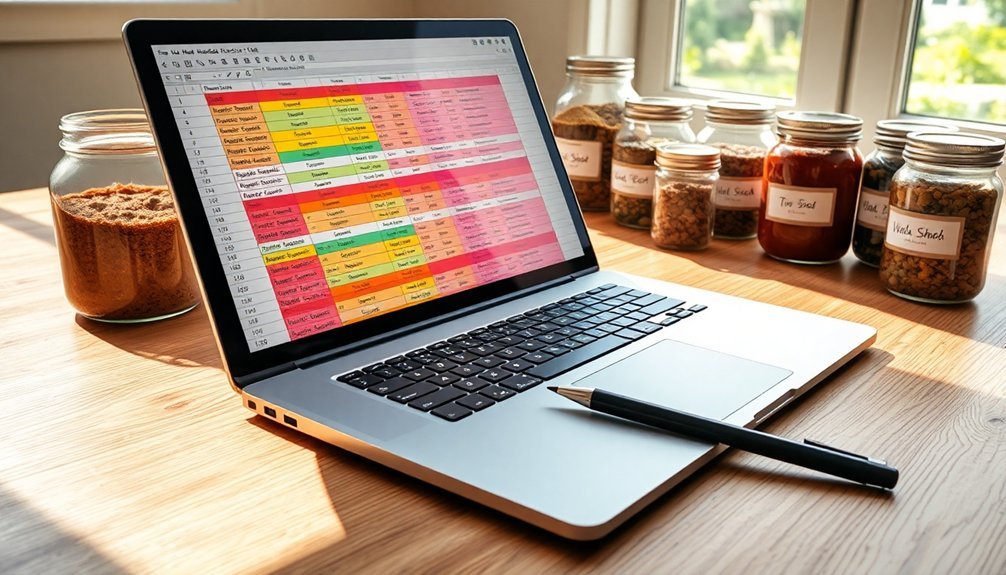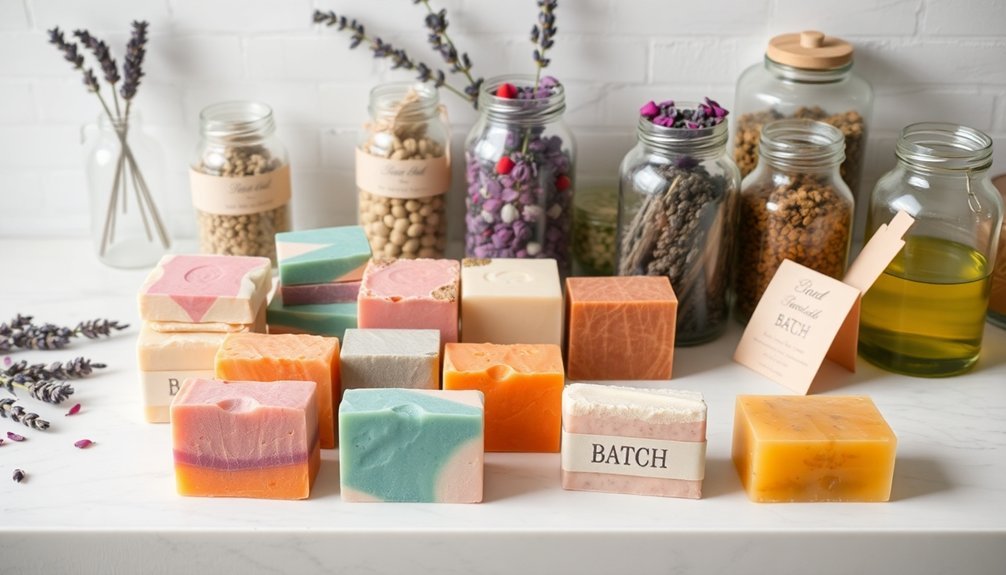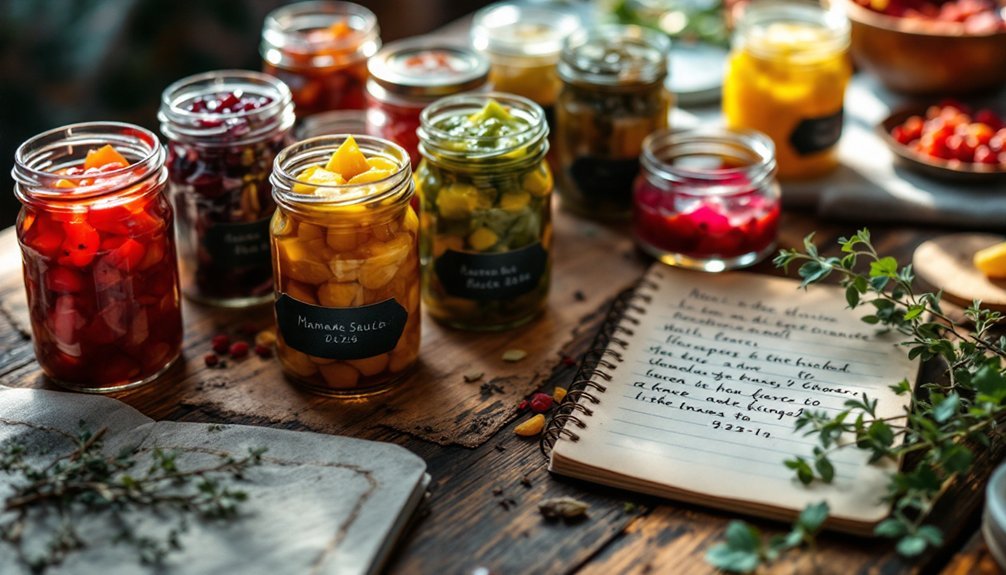Tracking your handmade batches doesn't need complex systems. You can use paper-based batch cards to document essential details, create digital spreadsheets for organized recipe management, implement QR code labels for instant information access, maintain photographic records of each batch, or assign unique batch numbers for every production run. These straightforward methods help maintain quality control and meet regulatory requirements. Discover how these tracking techniques can transform your handmade business into a more professional operation.
5 Simple Ways To Track Handmade Batches
Five essential methods can transform how you manage your handmade product inventory. Start by assigning unique batch numbers to each production run, recording manufacturing dates, materials used, and product specifications for complete traceability.
Consider software solutions like Craftybase, designed specifically for handmade goods, or MRPeasy for more complex operations. Even basic Excel spreadsheets work well for smaller businesses.
Implement tracking technologies such as barcodes or QR codes to quickly scan and update batch information. For efficient stock rotation, adopt FIFO or FEFO systems to guarantee older batches sell first. Regular inventory audits help identify data discrepancies and maintain accurate stock levels.
Don't overlook compliance requirements—maintain detailed documentation of batch information, quality checks, and supplier details. This structured approach not only improves organization but provides vital protection if product recalls become necessary.
Paper-Based Batch Cards for Small Soap Productions
Three qualities make paper-based batch cards invaluable for small soap businesses: simplicity, reliability, and accessibility. When you're just starting out, these tangible records help you maintain consistent quality without investing in complex systems.
Your batch cards should include:
- Product name, description, and batch number
- Production date and curing timeline
- Complete ingredient list with quantities and supplier information
- Step-by-step manufacturing notes including temperatures
- Space for observations and deviations from standard procedures
Create a template that you can easily replicate for each batch, and consider organizing your cards in a dedicated binder. These physical records are essential for real-time recording which ensures accuracy and prevents details from being forgotten during the production process.
Unlike digital methods, paper cards require no tech expertise or internet connection, making them perfect for hands-on production environments. You'll appreciate having physical records at your fingertips when tracking product development or addressing quality concerns.
Digital Spreadsheet Systems for Recipe Documentation

Spreadsheets offer handcrafted soap makers a digital evolution from paper-based records, providing flexibility and automation capabilities that scale with your business. Tools like Google Sheets and Excel let you create detailed documentation systems with dedicated columns for recipe names, types, ingredients, and process notes.
Set up your spreadsheet with essential fields including batch numbers, production dates, cure times, and customer feedback. You'll benefit from automation features that calculate ingredient percentages, track inventory, and even generate shopping lists based on planned production.
Unlike paper cards, digital systems allow you to search instantly, share recipes with team members, and access your formulations from any device. This approach centralizes recipes for easy access across all your devices, eliminating frustration when trying to locate specific formulations.
Plus, you can easily back up your data, ensuring your valuable recipe collection remains safe even if your computer fails.
QR Code Labels for Comprehensive Batch History
While traditional labeling methods serve basic identification needs, QR codes transform how handcrafters track and share batch information. These small digital squares pack extensive tracking capabilities, allowing you to document detailed batch histories that customers can access with a simple scan.
QR codes revolutionize batch tracking for artisans, offering digital documentation that customers access with a simple smartphone scan.
- Create custom QR codes (minimum 2cm × 2cm) with your logo and brand colors
- Link directly to batch-specific details including ingredients, production dates, and compliance information
- Enable customers to verify authenticity and provide immediate feedback
- Update information dynamically without reprinting labels
- Simplify inventory management by connecting codes to your digital tracking system
You can easily print QR labels using standard printers with Avery labels or dedicated label printers.
Most customers can scan your codes with their smartphone's native camera app, creating an effortless connection between your handmade products and their digital history. Adding clear scanning instructions beside your QR codes ensures both Android and iOS users can easily access your batch information.
Photography Method for Visual Soap Making Records

Beyond written records, photography provides a powerful and immediate method for documenting your soap batches. Use natural lighting without flash to capture true colors and textures, positioning your soaps against simple, medium-toned backgrounds for ideal contrast.
Take close-up shots to highlight distinctive features like swirls, botanicals, or textured tops. Apply the Rule of Thirds for balanced compositions, and experiment with multiple angles—overhead, side, and 45-degree views show different aspects of your creations. Using a stable tripod will eliminate camera shake and ensure your documentary photos remain consistently sharp.
When documenting batches, clearly photograph any labels or batch codes, and capture visual variations between productions.
For consistent visual records, implement basic editing: adjust lighting, enhance colors accurately, sharpen details, and crop distractions. Maintain a uniform style across your photographic soap journal for easy reference.
Frequently Asked Questions
How Long Should Batch Records Be Retained for Regulatory Compliance?
You should retain batch records for at least one year after the expiry date, or three years after distribution for API batches with retest dates, to guarantee full regulatory compliance and traceability.
Can Batch Tracking Systems Integrate With E-Commerce Platforms?
Yes, you'll find many batch tracking systems seamlessly integrate with e-commerce platforms. They'll sync your inventory across channels, automate order management, and provide real-time visibility through API connections and automated synchronization features.
What's the Minimum Batch Information Needed for Effective Recall Procedures?
You'll need product name, batch number, production date, ingredient list, and your contact information at minimum. This essential data lets you efficiently identify, locate, and communicate about specific products during a recall situation.
How Do Batch Tracking Methods Differ for Perishable vs. Non-Perishable Products?
For perishable products, you'll track expiration dates and temperature data with FEFO systems for safety. Non-perishables don't require time-sensitive tracking, allowing you to focus on simpler inventory counting and quality control measures.
Are There Affordable RFID Solutions for Very Small Handmade Businesses?
Yes, you'll find affordable RFID options through off-the-shelf systems and rental hardware. Consider reader-to-cloud solutions and plug-and-play systems that don't require complex coding—perfect for your small handmade business's budget and technical capabilities.
In Summary
You've now got five effective methods to keep your handmade soap batches organized. Whether you're using simple paper cards, digital spreadsheets, QR codes, photography, or a combination of these approaches, you'll never lose track of your formulations again. Implementing even one of these systems will save you time, reduce errors, and help you consistently create quality products your customers will love.





Leave a Reply